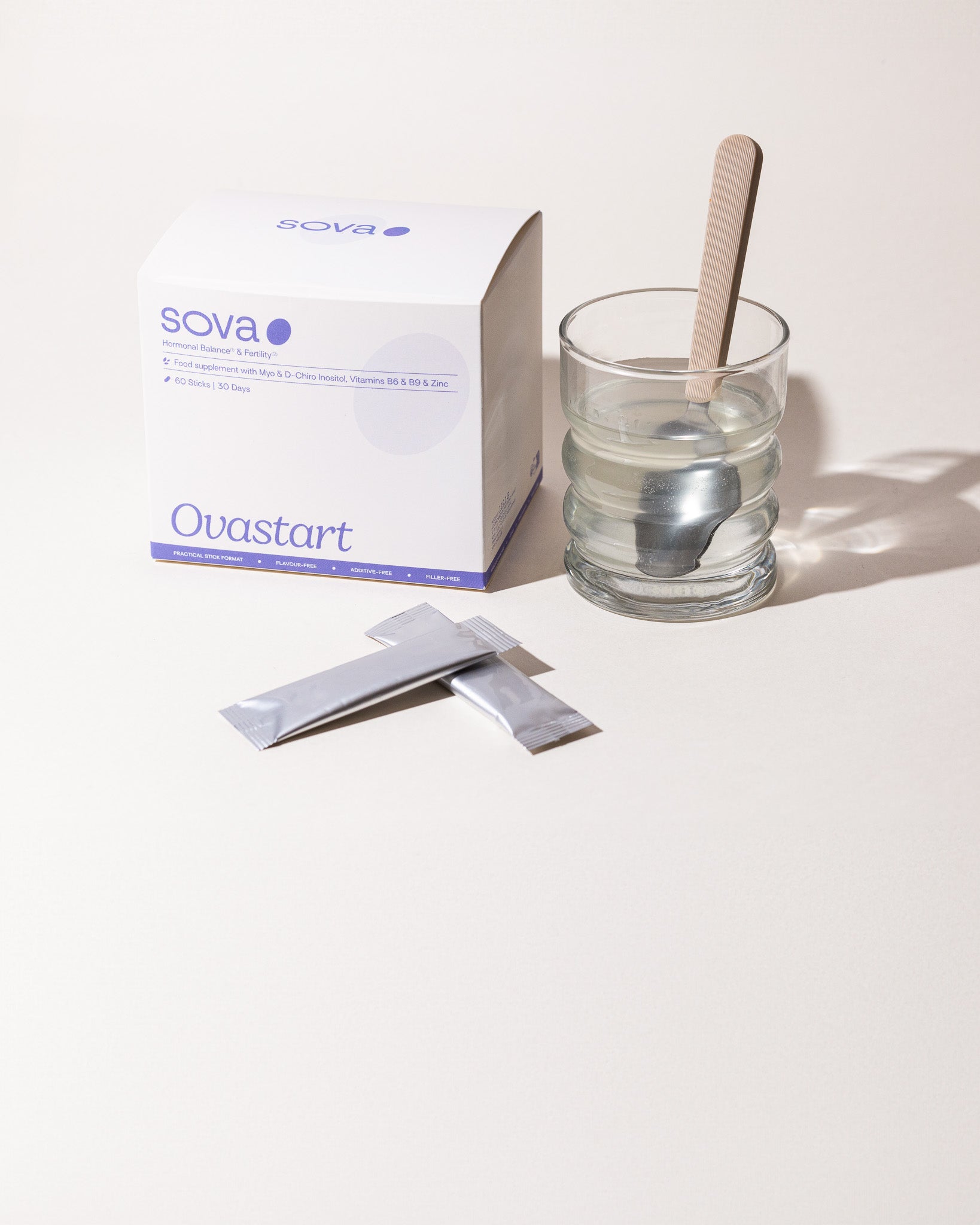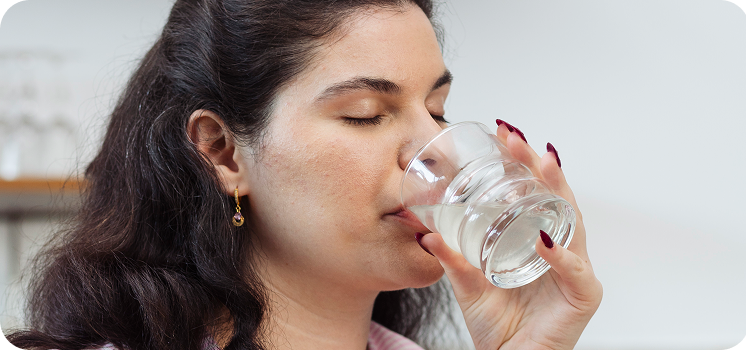Table of contents
If you have been diagnosed with PCOS (Polycystic Ovary Syndrome) and are planning on having a baby, this question must have crossed your mind early on: how to get pregnant with PCOS when hormones are unstable, cycles are highly irregular or absent, and still nothing after months of trying?
Fertility has become a significant societal issue due to its decline over the years. According to the OECD, the total fertility rate in the UK fell to 1.5 children per woman in 2022, one of the lowest levels recorded in recent decades (source).
Because of the rarity or absence of ovulation it may provoke, PCOS is, in fact, the leading cause of female infertility in the UK.
Even though there's no magic formula, rest assured: the majority of women affected by PCOS will eventually manage to get pregnant (either naturally or through assisted reproductive methods) (source).
However, to get the best out of this period of trials and waits—which can sometimes seem quite long—, it's a good idea to plan ahead your pregnancy project. For instance, you can stop hormonal contraception well in advance and even switch to other contraceptive methods if it's not yet the right time for your couple. This will allow you to see what your natural cycle is like, learn to observe yourself, and calmly implement actions to optimize your attempts when the time comes.
We’ll explain everything in this article!
📌 Tip: Not sure where to start? Try our Sova product quiz to discover which supplement routine can support your fertility journey.
Getting pregnant naturally with PCOS
Revisiting the basics of the menstrual cycle
Let’s begin with a brief reminder about the physiology of cycles and conception:
As you already know, a baby is the result of an encounter between a male gamete (spermatozoon or sperm cell) and a female gamete (ovum or egg cell). While men are theoretically fertile every day of the month, this is not quite the case for women where only one ovulation happens per cycle (in rare cases, two egg cells are released but almost simultaneously).
If the egg cell is fertilised, it becomes an embryo, begins its cell division, and attaches to the endometrium wall: this is called the implantation and marks the beginning of pregnancy.
Conversely, if there is no fertilisation, your endometrium detaches and gradually sheds: these are your periods. They happen a maximum of 16 days post-ovulation!
Note: It is possible to observe bleeding at regular intervals without it being menstruation! These are called intermenstrual bleeding. Don’t worry, this is relatively rare, but to be certain that you are ovulating correctly each cycle, you can, for example, chart your basal body temperature.

Learning to observe
When dealing with PCOS, we often face the challenge of irregular cycles which makes for difficult observations. Indeed, how to pinpoint ovulation when a cycle lasts 50 days and another 90?
In most cases, ovulation tests unfortunately aren't much help to clarify matters. PCOS is often characterised by a consistently high level of LH (luteinizing hormone), and it's this hormone that ovulation tests detect. Ovulation tests consistently show positive results quite often!
A closer look at LH: it's the ovulation-inducing hormone produced by the pituitary gland. When it reaches its peak, the egg cell is released 16 to 36 hours later. With PCOS, women’s LH levels are often high without ever producing a true peak. This is one of the reasons why ovulation doesn't occur regularly.
In cases where LH levels remain at a reasonable level, ovulation tests can be used, but it requires perseverance as you need to test diligently every day of your cycle, even when ovulation takes weeks to occur! For this reason, we advise you to buy ovulation test kits online and in bulk (for example, on Amazon) rather than at the pharmacy. It will be much cheaper for you.
Another way to detect ovulation is to closely observe your cervical mucus (which can sometimes be confused with white or vaginal discharges). It changes throughout the cycle, becoming more abundant, stringy, and giving you a feeling of moisture. When you notice this type of mucus, ovulation is closeby!
It's possible to observe several occurrences of quality increased cervical mucus during the cycle. Each episode is an ovulation attempt until your body finally manages to expel a mature egg cell.
Other signs that may indicate ovulation include cramping, localised pain on the left or right side, fatigue, and even a slight bleeding. Your cervix also changes position throughout the cycle (it's usually high, soft, and open during ovulation, then low, hard, and closed in the postovulatory phase).
Don't get disheartened! At first, it may seem difficult or even impossible to track your cycle, but over time and by noting your observations (for example, in a cycle tracking app), you'll come to better understand the mechanisms behind your cycle. This is essential because it allows you to target your fertility window and have intercourse with your partner at the best times!
By the way, sperm cells can live up to 4 to 6 days in your cervical mucus in favourable conditions (adequate cervical mucus, etc.). However, an egg is very fragile as it will only survive for an average of 12 hours to 24 hours tops. So, it's better to have intercourse in the days leading up to ovulation and the day of ovulation, rather than on the day of ovulation and the days that follow. Once the egg has been released, it's almost too late!
👉 If you need a step-by-step, check our article on monitoring your cycle with PCOS.
Regulating the Cycle
It's entirely possible to get pregnant even when you have long and irregular cycles. As proof, one of my patients became pregnant while ovulating on Day 100!
However, this does make things more complex and it will often take much longer. On average, we have a 20-25% chance of getting pregnant each cycle. But if your cycles last 2, 3, 4 months and more, you naturally have fewer odds per year than a woman with more regular cycles. With a 28-day cycle, that leaves about 12 or 13 chances to get pregnant per year, whereas with PCOS, we may only have 3 or 4 ovulations per year, depending.
So, the key will be to regulate your cycle.
This may involve overhauling your lifestyle (diet, stress management, sleep), and if necessary, taking dietary supplements. Weight loss can also promote ovulation, but it's not automatic. However, rapid weight loss can also have negative outcomes, so don't hesitate to seek guidance from a nutritionist or dietitian if needed.
Regarding dietary supplements, inositol (especially the forms contained in Ovastart) has shown good results in regulating menstrual cycles, especially if you’re suffering from insulin resistance.
There are many other supplements available. If you want to learn more about them, everything is explained in the article "The Best Dietary Supplements for PCOS."
If you're a bit lost and struggling to know which supplements or herbs would be most suitable for your profile, don't hesitate to seek help from a specialised professional. It's their job to sort out the different aspects of your hormonal profile and give you precise recommendations to help restore a more regular cycle and ovulation.
✨ Our tip: Ovastart contains inositol, an ingredient clinically shown to regulate cycles and support ovulation—especially if you have insulin resistance.
If you’re not sure which supplement is right for you, the product quiz is a great starting point.
Improving Egg Quality
This is another major issue for women with PCOS where hormonal processes are suboptimal and can negatively impact egg quality. Insulin resistance (which affects about 70% of women with PCOS) is often present, as well as inflammation.
Again, this problem needs to be addressed primarily through lifestyle changes. There are numerous studies demonstrating the impact of diet on egg quality. Stress levels or lack of sleep can also negatively affect them.
So, consider adopting a healthy, balanced diet (learn more here), and a suitable lifestyle. These changes will help regain a more harmonious hormonal balance and optimise the likelihood of getting pregnant.
These changes can be boosted with dietary supplements. Once again, inositol has a very positive impact on insulin resistance and egg quality. Methylated vitamin B9 (such as Quatrefolic in Ovastart) is also very important and supplementation is recommended even prior to any pregnancy to prevent malformations and miscarriages.
Omega-3s should primarily come from your diet. Should you feel that you’re not getting enough of them, it may be useful to supplement.
Remember that an egg takes about 3 months to develop so this is the minimum needed to expect initial positive effects!
Assisted Reproductive Techniques for Getting Pregnant with PCOS
Simple Stimulation: Clomid® (clomiphene citrate) & Duphaston® (dydrogesterone)
When cycles are too irregular, the first thing proposed by gynaecologists will often be a Clomid + Duphaston combination.
Duphaston triggers bleeding (which is not menstruation), thus giving a starting point to the cycle. Then Clomid is taken for about 5 days to stimulate ovulation.
Most of the time, gynaecologists will perform a control ultrasound to see if ovulation is preparing properly and then advise you on the ideal timing to have intercourse with your partner.
This type of simple stimulation generally yields good results!
Two things to know:
- The chances of twin pregnancies are higher with this type of treatment, especially in women with PCOS.
- Clomid tends to dry up cervical mucus, which is precious for receiving sperm cells and allowing them to reach the egg. Don't hesitate to discuss this with your gynaecologist or seek assistance from a professional. Many things can be done to promote good cervical mucus while taking Clomid.
Assisted Reproductive Techniques
When the first approach hasn't worked, or in specific cases (such as the partner's profile), other alternatives can be offered by medicine to get pregnant with PCOS such as artificial insemination and IVF.
In both cases, it's essential to work on the quality of your egg cells beforehand in order to maximise success with these techniques. Stimulations are always more delicate in women with PCOS because the risk of ovarian hyperstimulation is higher than in other women.
Furthermore, women with PCOS undergoing IVF often produce large numbers of eggs but with an inferior quality which may not always be good enough for fertilisation. This is a real difficulty that can be improved by changing your lifestyle, and primarily, your diet.
A study has demonstrated that the Mediterranean diet is as close as you can get to an ideal fertility diet, in addition to being beneficial for your health. It's a diet rich in high-quality olive oil, whole grains, fruits, vegetables, legumes, nuts, herbs, and spices. It also includes yoghurt, cheese, and lean proteins such as fish, chicken, and eggs.
Red meat, processed and therefore inflammatory food must be eaten in small quantities!
When dietary and lifestyle changes aren't enough, micronutrition (vitamins, minerals, etc.) can help boost egg quality. You will particularly need methylated vitamin B9 (as in Ovastart), a good overall status in each micronutrient, and various antioxidants that can truly make a difference (for example, inositol, but there are many others).
Consider supplementing at least 3 months before IVF or insemination and even 6 months prior, if possible. Do involve your partner in the process! To know which dietary supplements are most suitable to your profile while also being compatible with the medical protocols you’re following, get help from a professional.
💛 Final thoughts
Yes, PCOS can make getting pregnant more challenging—but it is absolutely possible.
By:
✔ Tracking your cycle carefully
✔ Supporting ovulation naturally
✔ Boosting egg quality with lifestyle and supplements
✔ Seeking medical help when needed
…you give yourself the best chance of conceiving.
👉 Explore our PCOS product quiz to see which supplement (like Ovastart or Sugar Balance) could help support your fertility goals.
💬 Remember: you are not alone in this journey. With the right guidance and a bit of patience, pregnancy is possible.
SOVA was created by two sisters with PCOS who wanted products that truly worked. Our formulas are developed in-house with women’s health and micronutrition experts, using ingredients backed by clinical studies and compliant with European regulations.
- Built by women with PCOS, we know the reality of the symptoms.
- Clinically studied, high-quality ingredients, including patented forms like Quatrefolic® and an optimal Myo-/D-Chiro Inositol ratio.
- Holistic support for hormonal balance, metabolic health, inflammation, mood and cycle regulation.
- Transparent, science-led formulas with no unnecessary additives.















